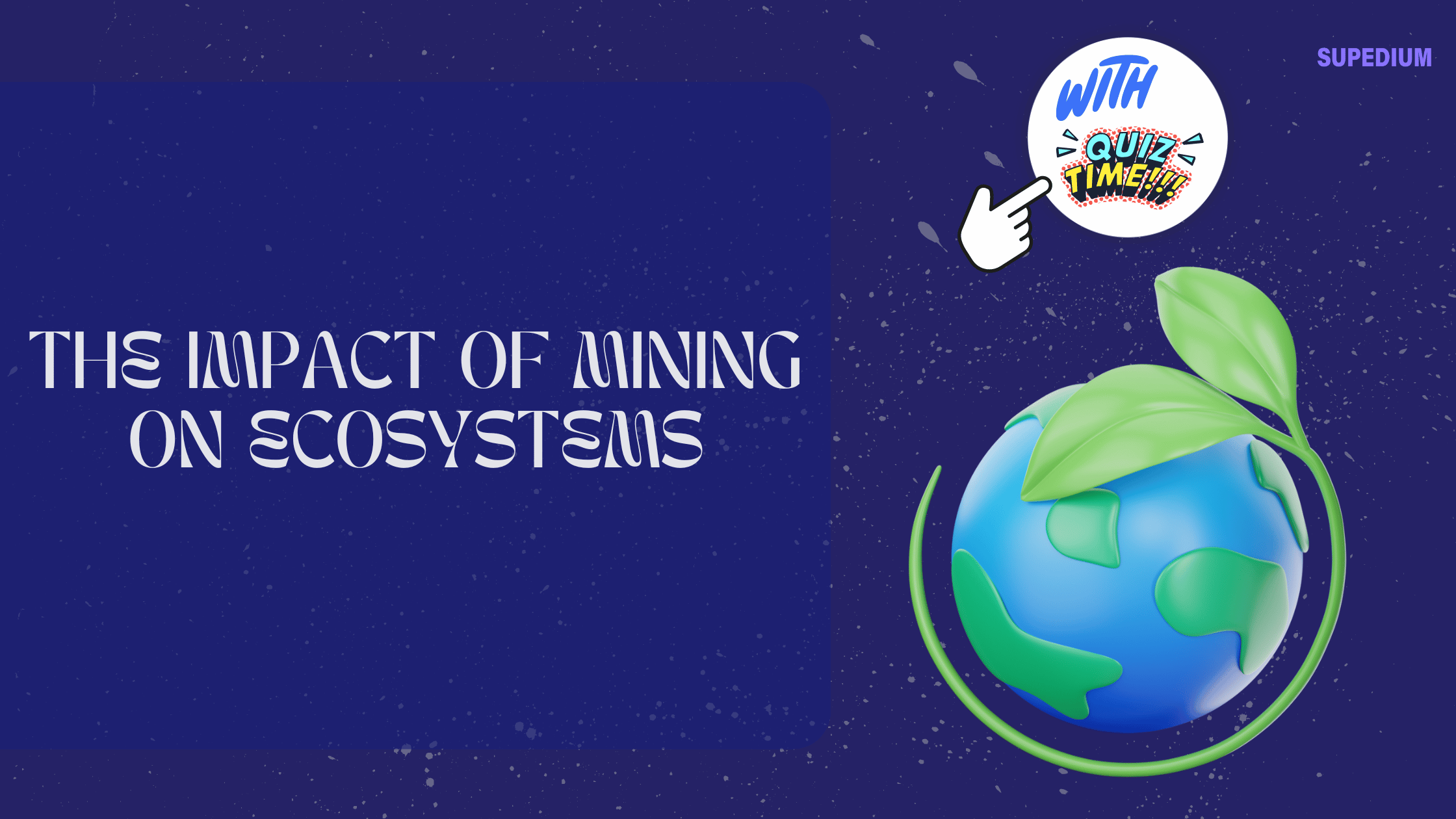Table of Contents
- 0.1 Understanding Mining and Ecosystems
- 0.2 Direct Impacts of Mining on Ecosystems
- 0.3 Indirect Impacts of Mining on Ecosystems
- 0.4 Social and Economic Impacts on Local Communities
- 0.5 Mitigation and Management Strategies
- 0.6 Case Studies
- 0.7 Future Directions and Emerging Technologies
- 0.8 Conclusion
- 1 Quiz Time
![]()
Mining, the extraction of minerals and other geological materials from the Earth, is a critical industry supporting global economies and providing essential raw materials for various industries. However, the environmental impacts of mining on ecosystems are profound and multifaceted. This article explores these impacts, the challenges faced by affected communities, and potential strategies for mitigating environmental damage.
Understanding Mining and Ecosystems
Definition of Mining
Mining involves extracting valuable minerals from the Earth. This can be done through various methods, including surface mining (such as open-pit or strip mining), underground mining, and mountaintop removal. Each method has its unique environmental footprint and implications for ecosystems.
Overview of Ecosystems
An ecosystem comprises all living organisms and their interactions with each other and their physical environment. Ecosystems can range from forests and wetlands to grasslands and deserts. Each type is uniquely adapted to its environment, and mining activities can disrupt these delicate balances.
Direct Impacts of Mining on Ecosystems
Habitat Destruction
One of the most immediate impacts of mining is the destruction of habitats. Large areas of vegetation are often cleared to access mineral deposits. This deforestation leads to the loss of critical habitats for wildlife and the fragmentation of ecosystems, making it difficult for species to survive and thrive.
Land Degradation
Mining operations can cause severe land degradation. The removal of topsoil and vegetation leads to erosion and soil compaction, which can alter landforms and disrupt local hydrology. These changes can lead to reduced soil fertility and increased susceptibility to landslides and erosion.
Water Pollution
Mining activities often result in significant water pollution. Acid mine drainage, a common problem, occurs when sulfide minerals exposed during mining react with air and water to form sulfuric acid. This acid can leach heavy metals into nearby water bodies, contaminating them. Sedimentation from mining operations can also increase turbidity in rivers and lakes, affecting aquatic life and water quality.
Air Pollution
Mining processes emit various pollutants into the atmosphere, including particulate matter and gases such as sulfur dioxide and carbon monoxide. These pollutants can degrade local and regional air quality, impacting both human health and the environment.
Indirect Impacts of Mining on Ecosystems
Fragmentation of Ecosystems
Mining infrastructure, such as roads and transportation networks, often fragments ecosystems, creating isolated patches of habitat. This fragmentation can disrupt animal migration patterns, reduce genetic diversity, and increase vulnerability to predation and competition.
Changes in Biodiversity
The loss of habitat and introduction of pollutants can lead to significant changes in biodiversity. Native species may decline or become extinct, while non-native species may invade and outcompete native flora and fauna. This shift can alter the structure and function of the ecosystem.
Altered Ecological Processes
Mining can disrupt essential ecological processes, such as nutrient cycling and water flow. The removal of vegetation and alteration of landforms can impact nutrient distribution and the natural flow of rivers and streams, affecting the overall health and functionality of ecosystems.
Social and Economic Impacts on Local Communities
Effects on Indigenous and Local Populations
Mining activities often impact indigenous and local communities, particularly those living in or near mining areas. Displacement from traditional lands can lead to cultural and social disruptions. The influx of workers and changes in land use can alter local economies and lifestyles.
Health Impacts
Communities near mining operations may experience health problems due to exposure to pollutants. Dust and chemical runoff can lead to respiratory issues, skin diseases, and other health problems. Mental health can also be affected by displacement and environmental changes.
Economic Benefits vs. Environmental Costs
While mining can provide economic benefits, such as job creation and infrastructure development, these must be weighed against the long-term environmental costs. Remediation and rehabilitation efforts can be costly and may not fully restore ecosystems to their pre-mining conditions.
Mitigation and Management Strategies
Environmental Impact Assessments (EIAs)
Environmental Impact Assessments are critical tools for evaluating the potential impacts of mining projects. EIAs help identify potential environmental risks and outline strategies to mitigate adverse effects. Effective EIAs can lead to more sustainable mining practices and better environmental outcomes.
Best Practices in Mining Operations
Adopting best practices in mining operations is essential for reducing environmental impacts. This includes using sustainable mining techniques, minimizing waste and pollution, and implementing efficient resource management practices.
Reclamation and Rehabilitation
Reclamation involves restoring land after mining operations have ceased. Rehabilitation aims to return disturbed areas to their natural state or to a condition that supports new forms of land use. Successful reclamation projects can help mitigate the long-term impacts of mining on ecosystems.
Policy and Regulation
National and international regulations play a crucial role in managing the environmental impacts of mining. Policies that enforce environmental standards and encourage sustainable practices are vital for protecting ecosystems. Environmental organizations and advocacy groups also contribute to promoting responsible mining practices and holding companies accountable.
Case Studies
Successful Mitigation Efforts
- Example 1: Reclamation Projects
In several countries, successful reclamation projects have demonstrated the potential for restoring mined lands. For instance, the Bingham Canyon Mine in Utah, USA, has undergone extensive reclamation efforts, including replanting vegetation and stabilizing soil to mitigate erosion. - Example 2: Pollution Control Measures
The Mount Polley Mine in British Columbia, Canada, implemented advanced pollution control measures to address water contamination issues. These measures included improving waste management systems and monitoring water quality to reduce the impact on nearby aquatic ecosystems.
Failures and Lessons Learned
- Example 1: Major Environmental Disasters
The 2015 Samarco mine disaster in Brazil highlighted the severe consequences of inadequate environmental management. The failure of a tailings dam led to the release of toxic sludge into local rivers, causing extensive environmental damage and displacement of communities. - Example 2: Ineffective Regulations
In some regions, weak or poorly enforced regulations have allowed mining companies to operate with minimal environmental oversight. This has led to widespread environmental degradation and highlighted the need for stronger regulatory frameworks and enforcement mechanisms.
Future Directions and Emerging Technologies
Advances in Mining Technology
New technologies are being developed to minimize the environmental footprint of mining. Innovations such as automated and remote-controlled mining equipment, and advanced waste management systems, offer the potential to reduce environmental impacts and improve resource efficiency.
Integrating Ecosystem Considerations
Ecosystem-based management approaches are increasingly being adopted to balance mining activities with environmental conservation. These approaches involve considering the full range of ecosystem services and integrating environmental and social factors into decision-making processes.
Role of Public Awareness and Education
Raising public awareness about the impacts of mining is crucial for promoting sustainable practices. Education initiatives can encourage consumers to support responsible mining and advocate for stronger environmental protections.
Conclusion
Mining plays a vital role in modern economies but poses significant challenges to ecosystems. The direct and indirect impacts of mining can lead to habitat destruction, pollution, and changes in biodiversity. Balancing economic benefits with environmental conservation requires effective mitigation strategies, best practices, and strong regulatory frameworks. As technology advances and public awareness grows, the mining industry has the potential to adopt more sustainable practices and reduce its environmental footprint, ensuring that the benefits of mining do not come at the expense of the planet’s health.






Be the first to comment